Canada, a nation of sprawling landscapes, is also home to a rich variety of songbirds. From the coastal provinces to the craggy Rockies, the soundscape of Canada is filled with a constantly evolving mixtape of bird songs. Here, we explore nine of Canada’s most beautiful songbirds. Some can be found just about everywhere at any time. Others only flutter into the Great North for a brief melody or two. Whatever the case, they’re guaranteed to stun with their beautiful feathers and unique songs that ring out with so much clarity and brio from such a light, delicate creature.
O’ Canada: The Nature and Purpose of Birdsong
Defending Territory
Songbirds are the sonic sentinels of the natural world, marking their domains with unique calls and melodies. This aural marking serves as a signal to other birds, effectively saying, “This spot is taken.” In Canada’s expansive wilderness, this is especially vital. As the landscape changes from deciduous forests in the East to boreal forests and mountain ranges in the West, the repertoire of songs changes accordingly. Each species adapts its tune to suit its environment, or due to rapid shifts in their habitat.
Attracting Mates
Birdsong is also the music of love in the avian world. In the competitive arena of mating, a complex and melodious song often indicates a healthy, fit individual. Interestingly, some studies show that female birds have preferences for certain songs, suggesting that the music not only attracts but also plays a role in the selection of mates.
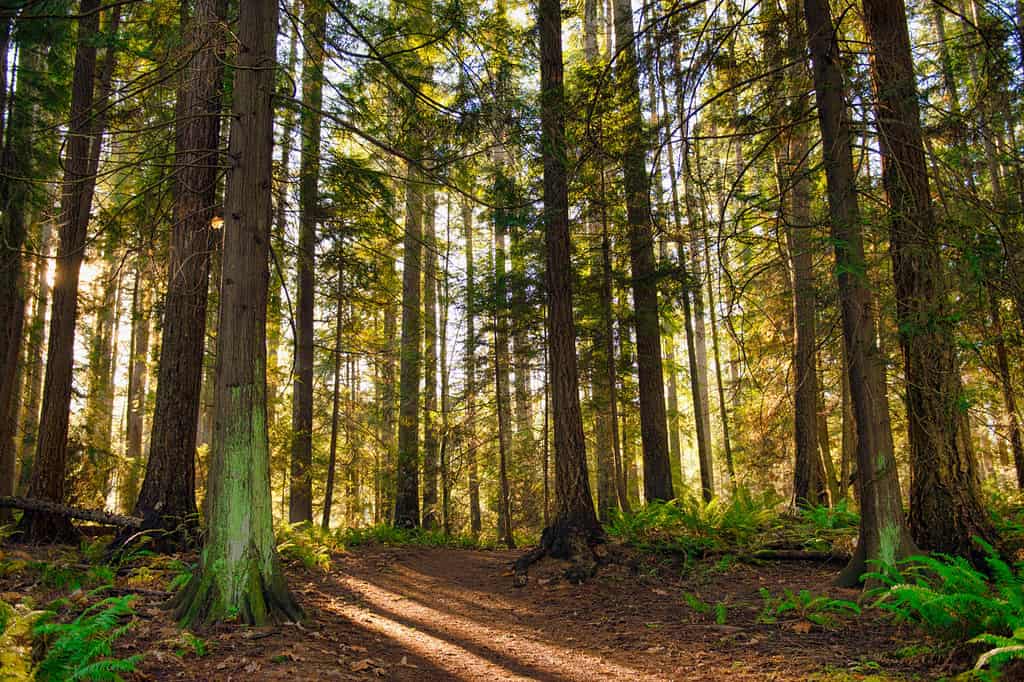
Songbirds adjust the speed of their song’s melody to the density of their environment.
©Roxana Gonzalez/Shutterstock.com
When the Air is Filled with Song: Songbird Seasonal Rhythms
Spring Through Early Fall
The most sonorous season for bird songs in Canada is from spring through early fall. Birds are most vocally active during these times as they defend their nesting territories and seek mates. The spring migration also adds to the cacophony, with species such as the Red-eyed Vireo and the Black-Capped Chickadee making their melodious contributions as they return from their winter flight.
Migration Season
Many birds migrate to or through Canada, making the migration periods in spring and fall spectacular times to listen to a mix of local and visiting songbirds. Some songbirds, like the Prothonotary Warbler, are only present in Canada during migration. As such, birders have only a limited window to experience their beautiful songs.
The Best Time of Day to Experience Songbirds
Early Morning
Just before the break of dawn, the “dawn chorus” begins. Songbirds like the Northern Cardinal and the Blue Jay are among the early risers, their songs serving as nature’s alarm clock. The early morning is a prime time for songbirds to sing because the air is usually still, allowing their songs to carry over greater distances.
Late Afternoon and Dusk
While mornings are peak times, many birds also vocalize in the late afternoon and at dusk. The Carolina Wren, for instance, is known to sing then.
Nighttime Melodies
While less common, some species do sing at night, especially during the full moon. Nighttime singers include the Alder Flycatcher, whose nocturnal songs add a mysterious note to Canada’s vast landscapes.
And Now the Beautiful Canadian Songbirds and Their Songs

A tiny Alder Flycatcher
©James W. Thompson/Shutterstock.com
Alder Flycatcher (Empidonax alnorum)
Description: Small olive-brown bird with a prominent eye-ring.
Song Characteristic: A sharp, “free-beer” call that resonates through its habitat.
Typical Behavior: Known for its acrobatic flights to catch insects mid-air.
Habitat: Wetlands and wooded areas across Canada.
Geographical Range: Mostly found in Eastern Canada but migrates to Central and Western regions.
Conservation Status: Least Concern.
Unique Fact: This bird species is a beneficial natural pest control, reducing insect populations.
The wet thickets of northern North America are the Alder Flycatcher’s home base. presents itself as a small yet dynamic avian specimen. At first glance, you might confuse it with the Willow Flycatcher. However, keen birders discern them by their range and vocalizations.
This bird holds the title for breeding farther north than any of the tyrant flycatcher family. There have been notable experiments on their behavioral nuances and song learning. Diving deep into its history, the Alder Flycatcher only gained its individual species status in 1973 when ornithologists formally split it from the Willow Flycatcher. Strange enough, the two do not respond to each other’s songs. This disconnection can perhaps be explained by their evolutionary divergence.
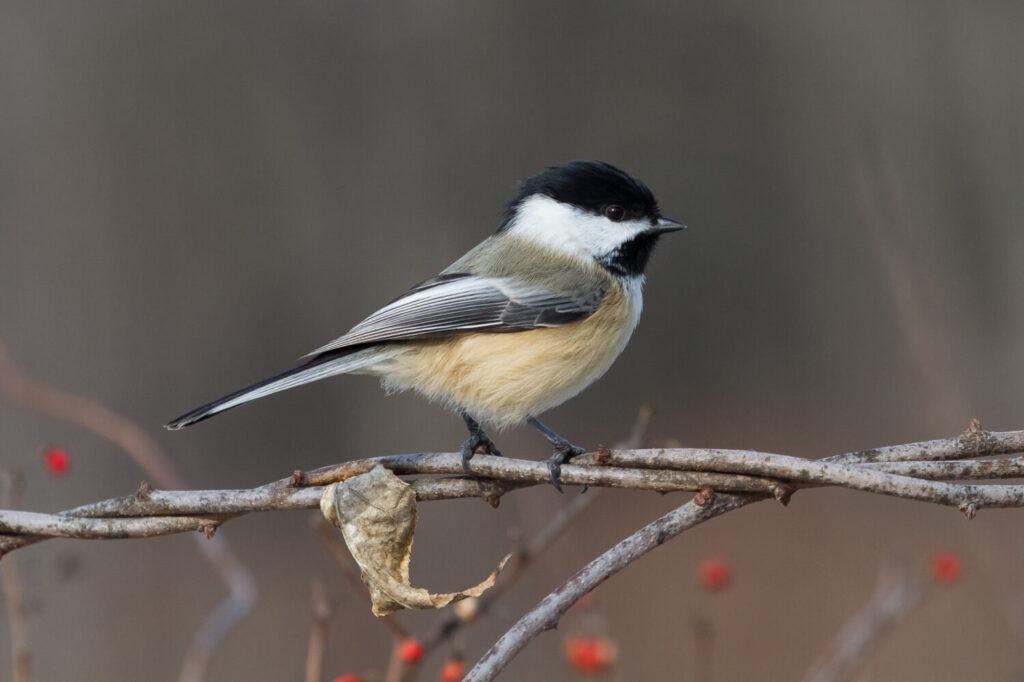
You can think of the Black-capped Chickadee as the
squirrel
of the avian world.
©Paul Roedding/Shutterstock.com
Black-capped Chickadees (Poecile atricapillus)
Description: Small, black-capped bird with white underparts.
Song Characteristic: High-pitched “chick-a-dee-dee-dee.”
Typical Behavior: Forages in flocks and stores food for winter.
Habitat: Deciduous and mixed forests.
Geographical Range: Throughout Canada.
Conservation Status: Least Concern.
Unique Fact: Capable of lowering their body temperature to endure harsh winters.
These petite birds with whimsical markings make their presence felt in wooded landscapes. They captivate birdwatchers with their charming traits and unique behaviors, from hiding food in concealed locations to replacing old brain neurons, a neurobiological feat that allows them to adapt to their environment.
Often spotted traveling in mixed-species flocks, Chickadees have a marked ability to recall thousands of hiding spots for food, a testament to their cognitive abilities. They can endure harsh cold temperatures by sleeping in individual cavities. These remarkable behaviors make them a fascinating subject for scientific study, and a joy for birdwatchers.
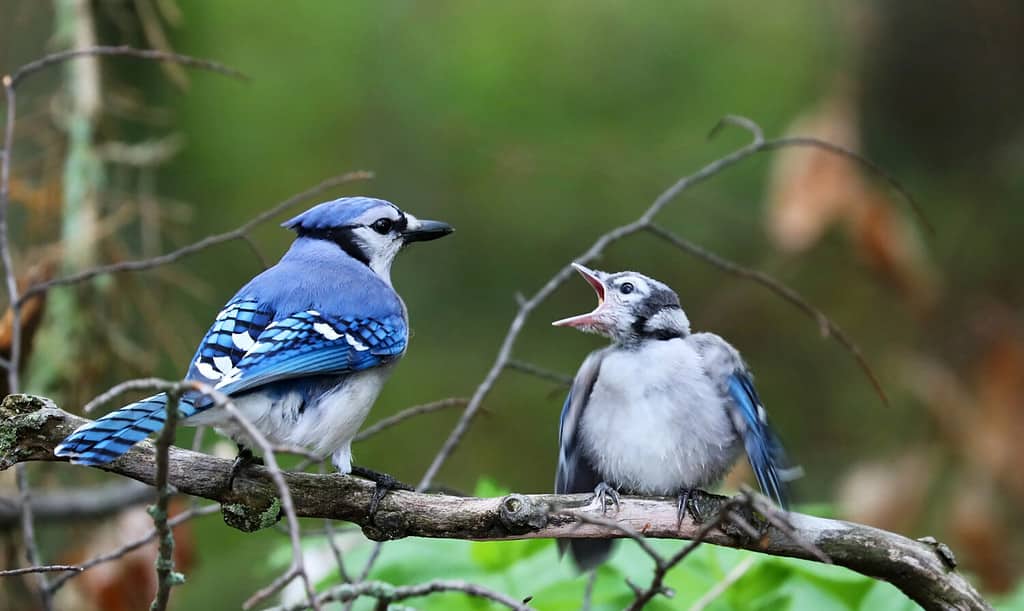
Clever and loud, Blue Jays are not actually blue (see below).
©Karel Bock/Shutterstock.com
Blue Jays (Cyanocitta cristata)
Description: Blue and white plumage with a crest on the head.
Song Characteristic: Varied calls, including mimicked hawk sounds.
Typical Behavior: Social and intelligent, often seen in pairs.
Habitat: Mixed forests and suburban areas.
Geographical Range: All across Canada.
Conservation Status: Least Concern.
Unique Fact: Their feather color results from light scattering (refraction in particular), not pigmentation. Their actually feather colors are grey and brown. Sorry, Toronto baseball fans—you’re wearing the wrong colors!
Blue Jays’ intelligence and social systems have long fascinated researchers, their migration patterns remain elusive. They form close-knit family bonds and serve a crucial ecological role in disseminating oak trees due to their obsession with acorns. Blue Jays are known to mimic the calls of hawks, adding a layer of complexity to their already intricate social behaviors.
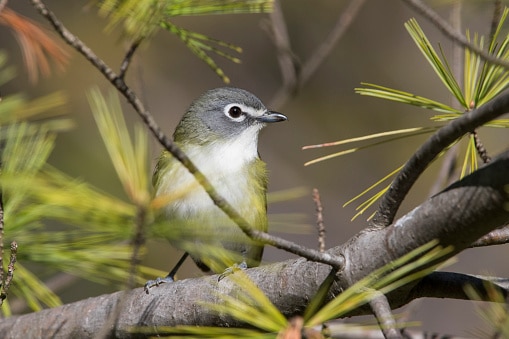
The Blue-headed Vireo’s nature is in its scientific name.
©mirceax/iStock via Getty Images
Blue-headed Vireo (Vireo solitarius)
Description: Bluish-gray head with greenish-yellow underparts.
Song Characteristic: A slow, melodious carol.
Typical Behavior: Solitary, often found at higher elevations.
Habitat: Mature forests and forest edges.
Geographical Range: Eastern and Central Canada.
Conservation Status: Least Concern.
Unique Fact: Prefers specific habitats like forest edges with thick vegetation.
The Blue-headed Vireo comes to life in mature forests. Unlike other birds that flock to feeders, this species relies on specific habitats like forest edges. Here, vegetation thrives in thick tangles, providing natural lookouts for avid birders. What makes this vireo distinctive is its color palette. Known for being difficult to spot, it’s their slow, melodious song that often gives them away.
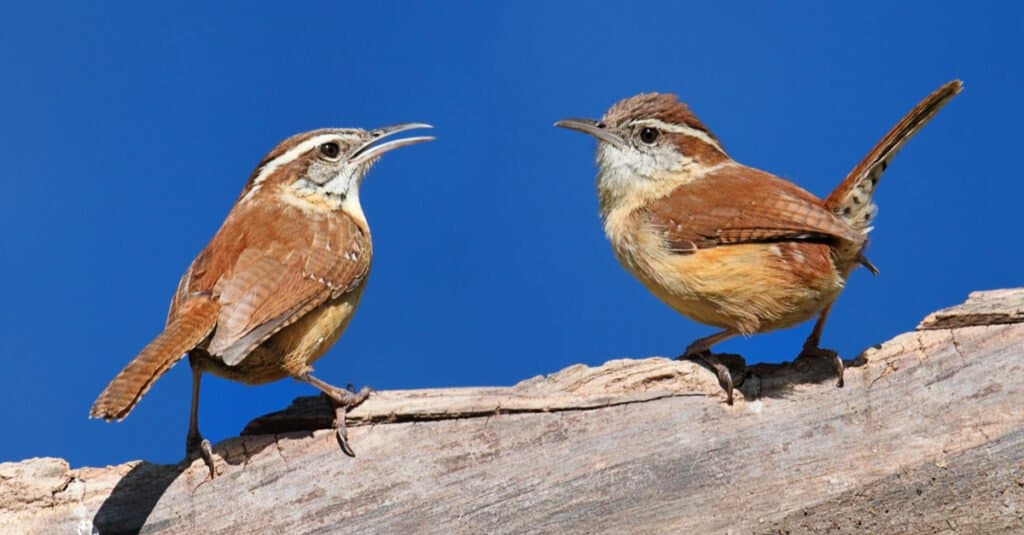
With a warmer climate, Carolina Wrens have been venturing further north into Canada.
©Steve Byland/Shutterstock.com
Carolina Wren (Thryothorus ludovicianus)
Description: Rich cinnamon plumage with a distinct white eyebrow stripe.
Song Characteristic: A loud, repeating “teakettle” call.
Typical Behavior: Inquisitive, often foraging on the ground.
Habitat: Wooded and suburban areas.
Geographical Range: Southern Canada.
Conservation Status: Least Concern.
Unique Fact: Highly sensitive to winter temperatures, shaping its distribution.
This small bird is the epitome of auditory grandeur. Their songs are a loud, repeating teakettle call that leaves an indelible mark on anyone who hears it.
Sadly, severe winters can decimate their populations. But the increasing trend of milder winters has emboldened their northward range expansion into Canada. This makes them a vivid, yet haunting, example of how climate change is affecting avian distributions.
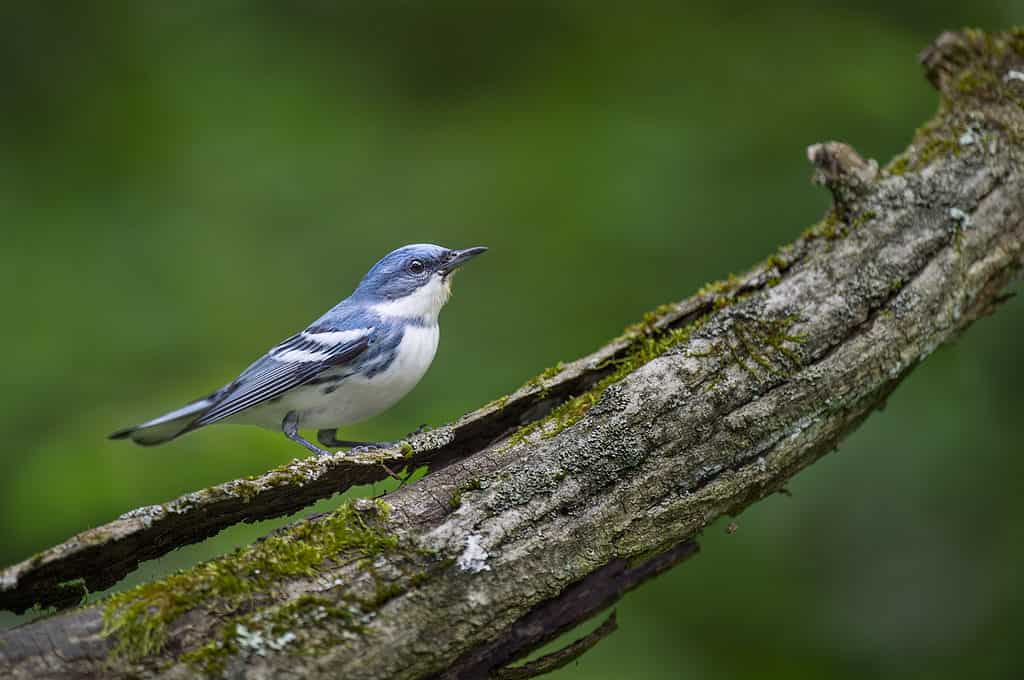
Of warblers, the Cerulean Warbler has seen the greatest decline in population.
©iStock.com/ps50ace
Cerulean Warbler (Setophaga cerulea)
Description: Striking blue plumage with white underparts.
Song Characteristic: A buzzy, ascending song.
Typical Behavior: Migratory, nests high in trees.
Habitat: Deciduous forests.
Geographical Range: Eastern Canada.
Conservation Status: Endangered.
Unique Fact: Experiencing population decline due to habitat loss, the Cerulean Warbler has suffered the largest population decrease of any other warbler during the 20th century.
Spotting a Cerulean Warbler could be likened to finding a sapphire in the rough. Dwelling in eastern deciduous forests during the summer months and migrating to the Andes in winter, these stunning blue songbirds are the sensory treat their cool and lovely name implies. But their beauty belies a grim reality of population decimation due to habitat loss, especially through forest fragmentation.
Females of this species demonstrate unique nesting behaviors, using spiderweb material for their nests and showing an unusual “bungee-jumping” action when exiting. These traits, alongside their vibrant plumage, make them a sought-after spectacle but also a bittersweet reminder of the importance of conservation.
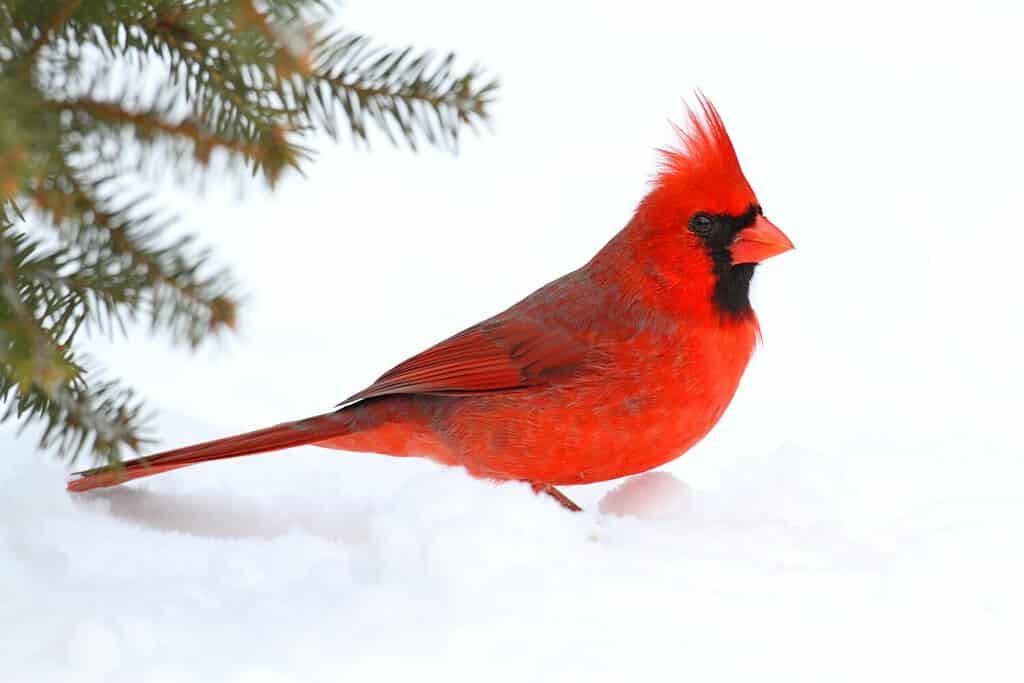
The male Northern Cardinals are very easy to spot, especially in winter.
©Steve Byland/Shutterstock.com
Northern Cardinal (Cardinalis cardinalis)
Description: Vibrant red plumage in males, duller in females.
Song Characteristic: Rich, repeating whistles.
Typical Behavior: Social and territorial, often seen in pairs.
Habitat: Woodlands, gardens, and parks.
Geographical Range: Southern Canada.
Conservation Status: Least Concern.
Unique Fact: Retains its vivid coloration year-round.
A symbol of vitality and spirit, the male Northern Cardinal’s vibrant red plumage stands out like a flame in the forest, making it one of the most easily recognizable birds in North America. But beyond its striking appearance lies a complex social structure and broad range of calls.
During the breeding season, both males and females may display territorial behavior, even attacking their own reflections. But no, they are not related to puppies and kittens. This hyper self-defense makes the Northern Cardinal one of the most fascinating birds to study. Additionally, its ability to retain its brilliant hue all year round is a delight for birdwatchers, especially during winter months when the land presents a blank white canvas.
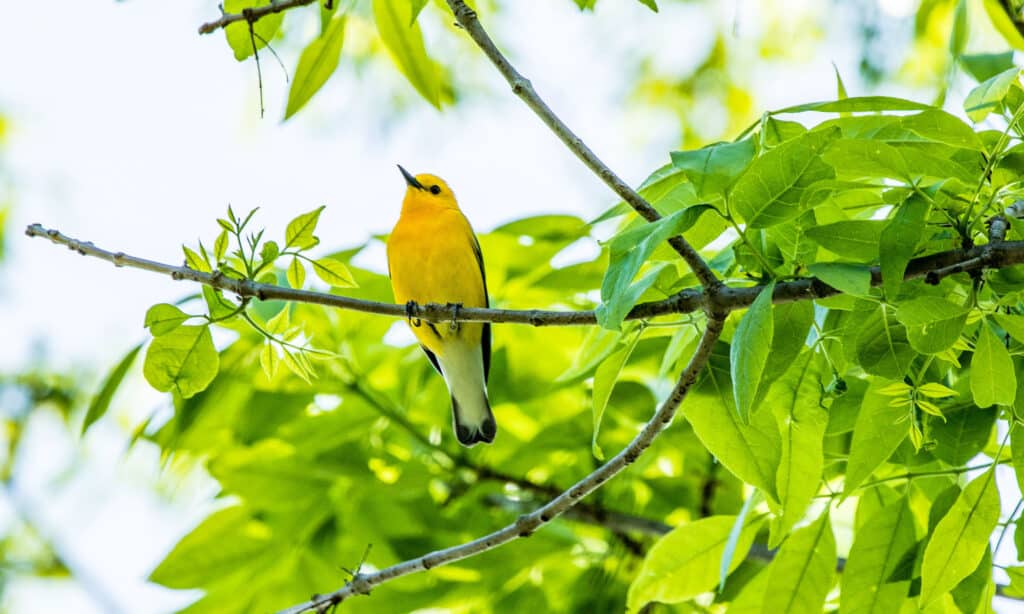
While only “near threatened” in the US, the Prothonotary Warbler is considered “endangered” in Canada.
©Mark C. Morris/Shutterstock.com
Prothonotary Warbler (Protonotaria citrea)
Description: Bright golden-yellow plumage.
Song Characteristic: A sweet, high-pitched song.
Typical Behavior: Prefers nesting in dead trees near water.
Habitat: Swamp forests.
Geographical Range: Rare in Canada, mostly in the southeastern parts.
Conservation Status: Endangered (in Canada, near threatened in the United States)
Unique Fact: Named after the yellow robes of papal clerks in the Roman Catholic Church.
Found mainly in the swamp forests of the southeastern United States, the Prothonotary Warbler still maintains a presence in southwestern Ontario. Nesting along the north shore of Lake Erie, their populations are declining and their future tenuous. What makes this bird a rarity among warblers is its nesting behavior, favoring standing dead trees as nesting sites. Unfortunately, it’s this habitat preference that makes them vulnerable to changes in water levels, showing the impact of environmental changes on bird populations.

Along with the Black-capped
Chickadee
, the White-breasted Nuthatch squirrels away food for later.
©Jim Nelson/Shutterstock.com
White-breasted Nuthatch (Sitta carolinensis)
Description: Blue-gray back with a white breast and face.
Song Characteristic: A nasal “yank-yank” or a series of whistles.
Typical Behavior: Forages headfirst down tree trunks.
Habitat: Forests and woodlands.
Geographical Range: Throughout Canada.
Conservation Status: Least Concern.
Unique Fact: Capable of storing food in tree bark for later consumption, an intriguing foraging strategy.
The White-breasted Nuthatch’s signature behavior involves creeping headfirst down tree trunks. This provides a unique viewing spectacle for bird enthusiasts, as well as some confusion among observant civilians. Its expansive range makes it one of the more adaptable species among North American birds.
Moreover, they’re an interesting case of evolutionary specialization. Their strong hindlimbs allow them to forage in unique positions, extracting insects and seeds from tree bark. The act of storing food for later consumption has also been observed in this species, suggesting cognitive specialization as well.
Conservation Status in Canada: The Interplay of Local and Global Efforts
Songbird Studies Canada and COSEWIC
Bird Studies Canada: This organization categorizes songbirds based on conservation concern, serving as a localized compass for safeguarding avian biodiversity.
COSEWIC (Committee on the Status of Endangered Wildlife in Canada): Provides official categorization for Canadian birds, listing them as endangered, threatened, or of special concern.

Headquartered in Switzerland, the International Union for Conservation of Nature (IUCN) is a 1,400-member-plus conservation and environmental network.
©Tobias Arhelger/Shutterstock.com
The IUCN Red List: A Global Benchmark
The IUCN Red List is a linchpin in conservation planning, providing crucial data that informs policy decisions and resource allocation, both globally and in Canada. As such, data and assessments from the Red List are fundamental to various international protocols. These include agreements like CITES (Convention on International Trade in Endangered Species) and CMS (Convention on Migratory Species).
Further, by closely aligning with United Nations Sustainable Development Goals, the Red List serves as a yardstick to gauge progress in achieving biodiversity targets.
Current Conservation Status
Fortunately, many of Canada’s songbirds are of “Least Concern,” echoing global assessments. However, for species like the Prothonotary Warbler, concerted conservation efforts are imperative. The Red List aids by identifying such species as “Near Threatened” Or “Endangered,” spurring on local initiatives.
Public Involvement: From Awareness to Action
Citizen Science
Engaging in local projects supplements global databases, enriching Red List assessments and providing a nuanced, on-the-ground perspective. There are several cell phone apps that make contributing as easy as cake. For example, the Merlin app from The Cornell Lab of Ornithology at Cornell University is free, fun, easy to use, and highly educational.
Donating to Bird Studies Canada
Financial support accelerates conservation, informed by broader metrics like those from the Red List.
Educational Impact and Awareness
Beyond metrics and organizations guidance, the Red List amplifies its reach through media coverage. This provides an educational effort outside of scientific journals that inserts birds’ status into the wider public discourse.
IUCN Red List of Threatened Species Evaluation Criteria
| Category | Description |
|---|---|
| Not Evaluated (NE) | Species that have not yet been evaluated against the criteria. |
| Data Deficient (DD) | Species for which there is inadequate information to assess their risk of extinction based on distribution and/or population status. Although their biology may be well-known, data on abundance and/or distribution are lacking. |
| Least Concern (LC) | Species that have been evaluated against the Red List criteria and do not qualify for a threatened category. They are not currently facing a high risk of extinction. |
| Near Threatened (NT) | Species that do not currently qualify for a threatened category but are close to qualifying or are likely to qualify in the near future. They may be at risk of becoming threatened if no conservation actions are taken. |
| Vulnerable (VU) | Species that face a high risk of extinction in the wild. The best available evidence indicates that they meet any of the criteria A to E for vulnerability. |
| Endangered (EN) | Species that face a very high risk of extinction in the wild. The best available evidence indicates that they meet any of the criteria A to E for endangerment. |
| Critically Endangered (CR) | Species that face an extremely high risk of extinction in the wild. The best available evidence indicates that they meet any of the criteria A to E for critically endangered status. |
| Extinct in the Wild (EW) | Species that are known to survive only in cultivation, captivity, or as naturalized populations outside their historic range. They are no longer found in their natural habitat. |
| Extinct (EX) | Species for which there is no reasonable doubt that the last individual has died. They are no longer in existence. |
Conclusion
While there are biological underpinnings, birdsong can’t help but be admired by humans as a pure expression of life. Then again, those very unromantic biological substrates serve as the scaffolding of life. In addition to their pied flare of feathers, these birds’ songs are one of our clearest windows into their lives. So, whether you’re venturing the damp forests of Vancouver, the pristine pines of Banff National Park, or even just strolling the Toronto Music Gardens, stop and listen to the little avian melodies that tell a story worth hearing, even if only for a moment.
| Bird Name | Conservation Status | Where Found in Canada |
|---|---|---|
| Alder Flycatcher | Least Concern | Across Canada, primarily Eastern regions |
| Black-Capped Chickadee | Least Concern | Nationwide, particularly in forested areas |
| Blue Jay | Least Concern | Eastern and Central Canada, extending to the Prairies |
| Blue-headed Vireo | Least Concern | Eastern Canada, particularly in deciduous and mixed forests |
| Carolina Wren | Least Concern, but Locally Rare | Southern Ontario and areas near the US border |
| Cerulean Warbler | Endangered | Restricted to southeastern Canada, particularly Ontario |
| Northern Cardinal | Least Concern | Southern Canada, mainly in Ontario and Quebec |
| Prothonotary Warblers | Endangered, Near Threated in the US | Very rare, primarily southwestern Ontario |
| White-breasted Nuthatch | Least Concern | Nationwide, particularly in forested regions |
The photo featured at the top of this post is © Bonnie Taylor Barry/Shutterstock.com
Thank you for reading! Have some feedback for us? Contact the AZ Animals editorial team.







